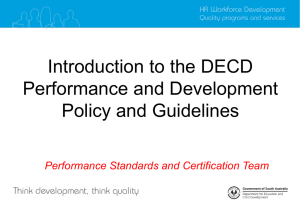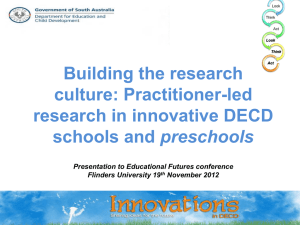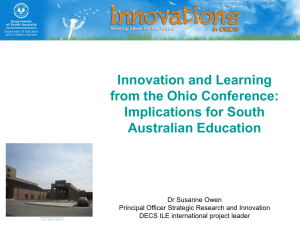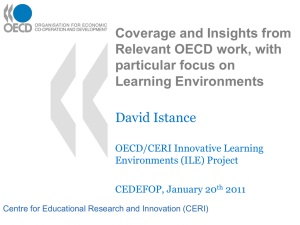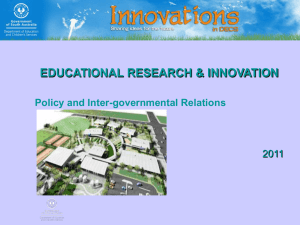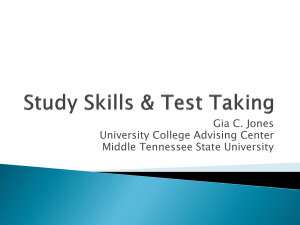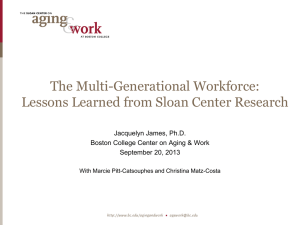Innovation provocation
advertisement
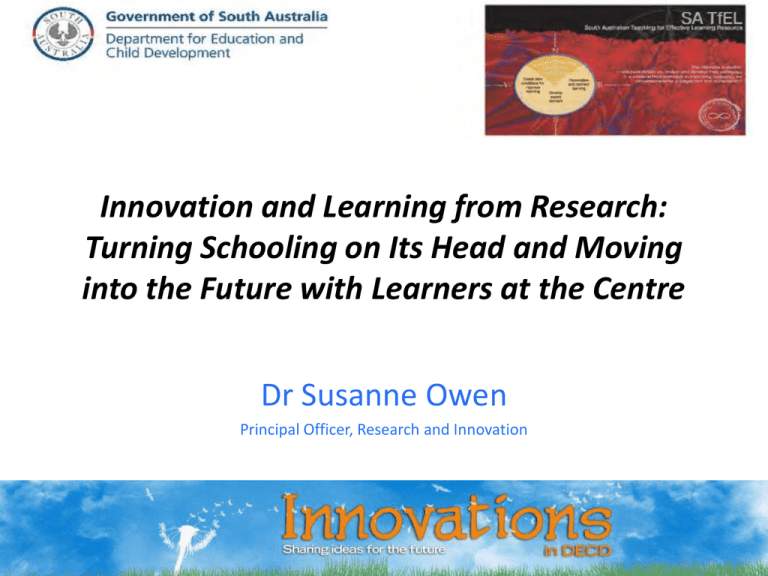
Innovation and Learning from Research: Turning Schooling on Its Head and Moving into the Future with Learners at the Centre Dr Susanne Owen Principal Officer, Research and Innovation Innovation & research definitions Research: Any creative systematic activity undertaken in order to increase ….. knowledge of man, culture and society, and the use of this knowledge to devise new applications (DECD Research & Innovation Framework, citing UNESCO) Innovation is about the ‘creation and implementation of new processes, products, services and methods of delivery which result in significant improvements in the efficiency, effectiveness or quality of outcomes (and) the application of new ideas to produce better outcomes’ (ANAO, 2009:1) Innovation may occur ‘through continuous improvement processes, adapting ideas from elsewhere or futures-oriented and transformative change’ (DECD, 2010:1) Why Innovative Education and putting learners at the centre: we’re already doing this, aren’t we? • Traditional schools not necessarily delivering well for 21st century agendas & for some students/groups • Knowledge is recognised as central in transforming societies and economies & concerns re economic loss from underutilisation of human potential • Measuring learning outcomes highlights need for finding new ways to change outcomes and to re-focus on the learning environment • Secondary student disengagement concerns: reduces to about 30% by age 15 (Dunleavy & Milton, 2012; Wilms, Friesen & Milton, 2009) • Little higher order thinking, innovative & individualised learning occurring & new educational possibilities are arising from ICTs (OECD 2007 TALIS research of 70000 teachers in 24 countries re 15 year olds) • Traditional v Innovative thinking • • • • • • • • Logical Deductive reasoning Requires proof Looks for precedents Quick to decide Right and wrong Ambiguity discomfort Wants results (Centre for Creative Leadership) Intuitive Considering multiple possibilities Asks what if? Unconstrained by the past Reflective, considers complexity Considers other ways Relishes ambiguity Wants meaning Innovative thinking skills What’s involved in Educational Innovation? • Some risk-taking but also an intentional departure from traditional approaches to better meet the needs of learners : be truly innovative. • Settings providing optimal learning and development in cognitive, meta-cognitive and socio-emotional terms. • Be aimed at addressing the contemporary learning and educational needs of all learners. • Not rely on the vision, understanding or personality of a single or small group of innovators. Rather, the innovation must be sustainable, supported by a broad organisational foundation. • Involve formal or informal evaluation of practice for the purpose of promoting continual improvement. Educational innovation models and characteristics RADICAL INNOVATION INCREMENTAL INNOVATION • • • Minor modifications to existing product Swims with the tide Starts with the present & works forward • • • Significant breakthrough/ major shift in design Swims against the tide Starts with the future and works backwards School Improvement? LEARNERS New groupings, targeted for specific groups, learners define goals TEACHERS Teams & multidisciplinary teachers, coach/facilitator role, other adults/peers Transformation? CONTENT New foci for content, 21C competencies, values, co-constructed curricula RESOURCES Innovative uses of infrastructure, space, community and technology ORGANISATION Innovative approaches to scheduling, groupings, pedagogies, assessment & guidance (Sebba et al, 2007) (Grunwald Assoc, 2010) (Grunwald Assoc, 2010) (Grunwald Assoc, 2010) “At a crucial turning point in global history, we have to make daring and disruptive changes, not incremental adjustments – but without abandoning everything we have valued and achieved in the past” (Hargreaves and Shirley, 2009) “Examples of success in education are very similar. They involve lifting expectations of what’s possible [and].. having the courage to be creative and flexible in developing models that work in particular contexts, and being prepared to make and fix mistakes along the ways” (Mick Dodson, speech to National Press Club) The key to success is ‘creating a knowledge-rich profession in which schools and teachers have the authority to act, the necessary knowledge to do so wisely, and access to effective support systems’ (Schleicher OECD, in Caldwell and Harris, 2008) References Australian National Audit Office. (ANOA). (2009). Innovation in the Public Sector. URL: http://www.anao.gov.au/director/publications/betterpracguides DECD. (2010). Research and Innovation Framework. URL: http://www.decd.sa.gov.au/research/pages/research/Innovation/?reFlag=1 Grunwald Associates. Walden University. (2010). Educators, Technology and 21st Century Skills. Dispelling five Myths. Report Summary. URL: www.waldenu.edu/degree-programs/masters/36427.htm Hannon, V. (2011). Innovation. Keynote by Valerie Hannon at OECD Alberta conference. URL: http://www.oecd.org/document/31/0,3746,en_21571361_48488357_49028895_1_1_1_1,00.html Horth, D. & Buchner, D. (2009). Innovation Leadership. URL: http://www.ccl.org/leadership/pdf/research/InnovationLeadership.pdf Organisation for Economic Cooperation and Development (OECD). (2011). Inventory Case Study: Australian Science and Mathematics School. URL: www.oecd.org/dataoecd/37/42/48810775.pdf Sebba, J., Brown, N., Steward, S., Galton, M. & James, M. (2007). An Investigation of Personalised Learning Approaches Used by Schools. London: Department for Education and Skills. URL: www.canterbury.ac.uk/education/tfmentors/.../Personalised/.../DfESReport.pdf Wilms, J., Friesen, S. & Milton, P. (2009). What did you Do in School Today. Transforming Classrooms through Social, Academic and Intellectual Engagement. Toronto: Canadian Education association

